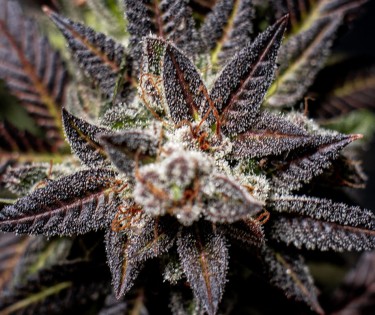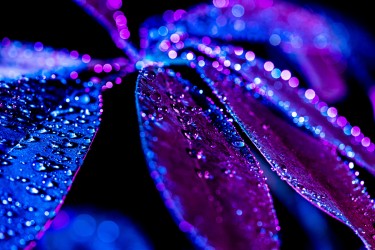
Are you familiar with black cannabis? Exploring various cannabis forums reveals conflicting opinions on the existence of black cannabis. Can certain strains attain such a dark hue that they appear black? Although uncommon, there are indeed strains of cannabis that exhibit deep black/purple/blue coloring.
However, this distinctive coloration only manifests under specific conditions. Let’s delve into the factors that contribute to the development of black cannabis strains.
What Causes Some Plants to Have a Darker Hue?
The prevailing climate heavily influences the alteration of color in plants. Cannabis cultivated in the warm Mediterranean typically displays a vibrant green color, while plants grown in cooler climates tend to produce compounds resulting in a purple hue.
The critical agents behind this phenomenon are anthocyanins, which serve as natural antifreeze for the plant. This antifreeze property aids in water retention, preventing water from escaping the leaves and forming ice crystals between leaf cells in freezing conditions. The cooler the growing climate, the greater the production of anthocyanins.
Some researchers propose that anthocyanins act as sunscreen, shielding plant leaves from specific light intensities and enhancing the absorption of other soft types. Anthocyanins stimulate the absorption of blue and green light wavelengths, with cannabis responding by producing more anthocyanins under certain stress conditions.
Furthermore, it is plausible that the coloration serves as an attractant for specific pollinators while deterring potential pests. Much like various flowers exhibiting a spectrum of colors, cannabis flowers can produce an array of hues.
During periods of drought, plants also tend to increase anthocyanin production. These theories collectively suggest that anthocyanin production is an adaptive trait enabling plants to thrive and endure specific environmental conditions.
If anthocyanins elucidate the purple coloration in cannabis, how does black come into play? Well, anthocyanin in cannabis is the same compound found in plants such as black rice, eggplant, black currants, and black/blue tomatoes. Consequently, the greater the presence of anthocyanins in a plant, the more profound its coloration becomes.
Color Genetics
The interplay between environmental conditions and genetics governs the coloration of plants. Cool climates stimulate increased anthocyanin production in plants, yet certain purple strains exhibit superior capabilities in generating this compound. For instance, strains like Black can produce leaves and buds with a deep purple, almost black hue in nearly any environment.
The hypothesis suggests that the Black strain possesses a recessive phenotype enabling enhanced conversion of glucose into anthocyanins. Offspring from the Black strain hybrids can display a diverse range of colors, ranging from purple to reddish and even white. To maintain a black coloration, the progeny must inherit a recessive gene from both parent plants.
pH Influence
Anthocyanins, responsible for red, purple, blue, and black hues, are influenced by pH levels. Cannabis plants naturally thrive in slightly acidic soil. However, the redder coloration intensifies with more acidic soil, while neutral pH promotes blue and purple hues.
To enhance the purple tones in your herb, maintaining a slightly higher pH within the optimal range of 5.8 to 6.8 on the pH scale is recommended.
Color and Potency
While some individuals perceive black strains as highly psychedelic and rich in THC, the color of the plant may not directly contribute to potency. Instead, certain strains with black phenotypes may have been selectively bred to produce elevated levels of THC. Indica plants, known for their propensity to turn purple more readily, are also believed to produce higher THC amounts naturally.
Effects on Consumption Experience
While color may or may not directly impact the overall consumption experience, anthocyanins, the compounds responsible for vibrant colors, offer many health benefits. Much like the advice to “eat the rainbow,” anthocyanins contribute to the reds, purples, and blues in the food color spectrum.
In humans, anthocyanins provide various health advantages, including protection against cardiovascular disease, antioxidant properties, cancer prevention, memory enhancement, anti-aging effects, immune regulation, and anti-inflammatory benefits.
Black Cannabis Varieties
Currently, some of the sought-after black strains available include:
1. Black Domina
Black Domina boasts captivating, uniform specimens distinguished by broad, dark green leaves and compact, resinous buds. With a sweet, incense-infused flavor, this Indica-dominant strain delivers a profound and potent relaxation experience, making it an ideal choice for those seeking medicinal and therapeutic benefits due to its elevated CBD levels.
Properties of Black Domina:
-
Sativa/Indica: 5/95%.
-
Flowering: 8-9 weeks indoors, end of September outdoors.
-
Yield: 400-500 g/m2 indoors, up to 1 kg per plant outdoors.
-
Height: 60-90 cm indoors, 1.5-2.5 m outdoors.
2. Black Jack
Formulated by Sweet Seeds, Black Jack is an intensely fragrant plant with a sweet, slightly lemony aftertaste reminiscent of the legendary Jack Herer. With high resin production, it allows for extract creation. Its balanced sativa and indica hybrid genes induce a euphoric sensation that transitions into a relaxing state, offering a unique experience.
Properties of Black Jack:
-
Sativa/Indica: 50/50%.
-
Flowering: 60-70 days indoors, mid-October outdoors.
-
Yield: 500 g/m2 indoors, 700 g per plant outdoors.
-
Height: up to 1.8 m indoors, 1.8-2.5 m outdoors.
3. Black Domina (Sensi Seeds)
Another classic cannabis strain, Black Domina by Sensi Seeds, is a product of crossing three potent Indica strains—Northern Lights, Ortega, Hash Plant, and Afghani S.A. Rich in resin content, this strain is perfect for enthusiasts of cannabis extracts. Its Indica dominance ensures high levels of relaxation, effectively alleviating muscle pain.
Properties of Black Domina:
-
Sativa/Indica: 5/95%.
-
Flowering: 8 weeks indoors, end of September outdoors.
-
Yield: up to 500 g/m2 indoors, 750 g per plant outdoors.
-
Height: 60-90 cm indoors, 1.5-2.5 m outdoors.
Black cannabis, though less known, is a unique and distinctive variety with its dark appearance, providing a distinct touch to cannabis cultivation.
Conclusion
The mystique of black cannabis goes beyond its unique appearance. It results from a fascinating interplay of environmental conditions, genetics, and the plant’s adaptive mechanisms. Whether you’re drawn to the allure of black cannabis for its potential potency or its distinct aesthetic appeal, these strains continue to captivate the cannabis community, adding a touch of enigma to the world of cultivation and consumption.
DARK COLORED WEED, READ ON…
20 PURPLE CANNABIS STRAINS TO CHECK OUT TODAY!
- SEO Powered Content & PR Distribution. Get Amplified Today.
- PlatoData.Network Vertical Generative Ai. Empower Yourself. Access Here.
- PlatoAiStream. Web3 Intelligence. Knowledge Amplified. Access Here.
- PlatoESG. Carbon, CleanTech, Energy, Environment, Solar, Waste Management. Access Here.
- PlatoHealth. Biotech and Clinical Trials Intelligence. Access Here.
- Source: http://cannabis.net/blog/strains/what-is-black-cannabis-and-can-you-smoke-it-do-you-get-high




